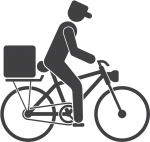There is no denying that as delivery technology has become increasingly available, it has dominated and changed the face of the foodservice industry. The prevalence of third-party delivery operators, like Uber Eats, Menulog, Grubhub and Postmates, are not showing signs of stopping. In fact, if anything, they are penetrating deeper into the industry and driving consumer dining trends. A report released by L.E.K. Consulting earlier this year entitled ‘Meals on Wheels: The Digital Ordering and Delivery Restaurant Revolution’ predicted that restaurant delivery is expected to grow at more than three times the rate of on-premises sales. But in this competitive environment, who is to say which delivery company is the best for business, or if it is better to provide an in-house delivery option? While in-house may be cheaper, it requires extra staff and may not provide access to as many customers as a third-party can.
In-house offerings can seriously challenge third-party delivery in established brands. Jimmy John’s in the U.S.A., for instance, offers its diners an 18 minute average delivery time—third-party often averages well over 40 minutes. This figure can be influential amongst diners who are largely convenience-driven. However, while Jimmy John’s has delivery embedded into their brand, they have the customer base to back it up. For a smaller provider, is in-house still the quickest way to attract as many customers as possible? In New Zealand, the average rate that a business will pay Uber Eats per order is 35 percent. However, larger companies, like McDonald’s, can use their global scale as leverage, supposedly paying as little as 20 percent. In some cases, whether businesses are paying 35 or 20 percent, it’s just not sustainable. Many companies have reported that their consumer is now 80 percent Uber Eats or third-party delivery customers, who then take around 30 percent of the income. Unless a venue has a big enough customer base to offset these charges, it doesn’t make sense for them to be signed up to something slowly taking away their money.
One thing, however, that third-party can offer a smaller business venture, is an opportunity to open a ghost kitchen. Although this requires enough capital to open and fitout a location, many smaller chains or stand-alone restaurants are considering this as an option to supplement income. Coco’s Cantina, for instance, opened a ghost kitchen through Uber Eats earlier this year. However, they branded it differently, hoping that customers wouldn’t think that the two are synonymous—just similar. But this isn’t an option for every business.
Calls are being made for third-party delivery businesses to take more responsibility for the market that their presence has created. At this stage, with most places involved in either third-party or both in-house and third-party, it seems unlikely that not offering either will ever be better. But it is perhaps a long game. Jump in with a third-party now and lose immediate income, but get your name into the vast pool of clients involved in third-party. Or, do you shun it now, and miss out on the delivery boom in the hope that you still have enough thoroughfare?
Uber Eats said that its restaurant base in New Zealand is over 1500. Uber Eats believes that through its platform, restaurants can grow and reach new customers with a fast and reliable delivery option. At 35 percent, however, is it worth it? If a venue is selling food for around $11-13, the profit that they are making per order is marginal—perhaps as little as $1-2 after tax and labour charges. If an establishment is serving $20-25 meals and above, perhaps there is more room for positive profit margin.
But this is up to the individual operator. Third-party offers a wider client base than most in-house delivery options. But in-house can work. Domino’s do it. But would this work with a brand that is not as established? There are difficulties when it comes to adapting to the modern dining trends, but for the most part, those that haven’t involved themselves in third-party, or at least thoroughly developed in-house delivery, have fallen behind. There is an argument for both sides that can be made, however, given the prevalence of third-party delivery, it seems likely that this will be the way of the future.






